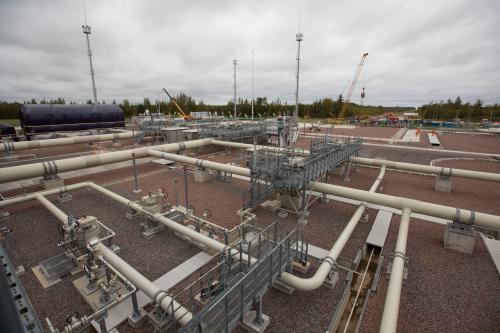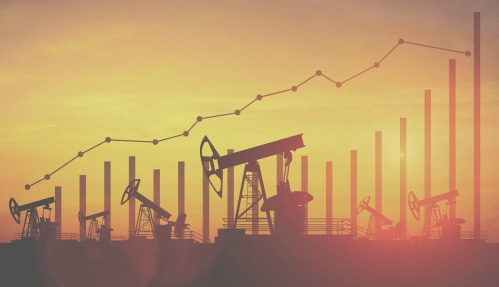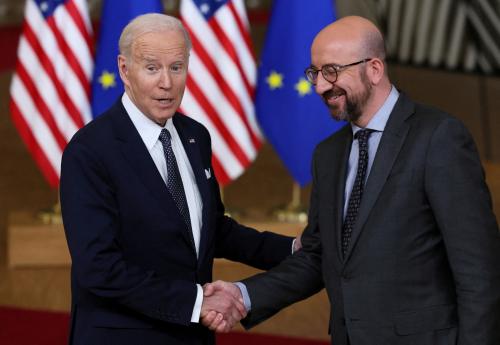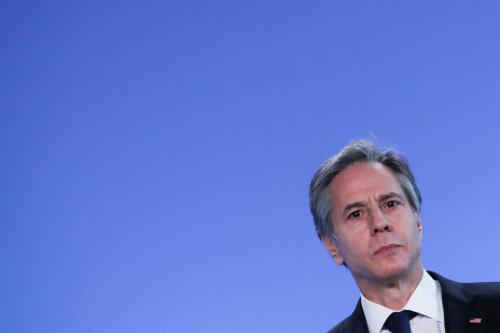Members of Congress from both parties are politicizing and spreading bad information on the energy crisis resulting from Russia’s invasion of Ukraine. Given the acrimony in U.S. politics today, this isn’t surprising, but misinformation on the real cause of high gasoline prices is a disservice to U.S. citizens. Democrats blame the oil and gas industry and Republicans blame President Joe Biden, but global market forces are the real culprit. Better understanding of the energy system, among policymakers and ordinary people, is crucial as the United States and world strive to transition to a system with net-zero greenhouse gas emissions.
Rising U.S. gasoline prices are the result of global oil market conditions. U.S. gasoline prices reached their highest average level ever (in nominal terms) of $4.41 per gallon in March, but prices have been rising steadily since they bottomed out in April 2020. Global and U.S. oil production decreased during the COVID-19 pandemic, as demand and prices plummeted. Now demand is recovering faster than production, leading to rising prices even before the Ukraine crisis. Since the invasion, Russian oil production generally is not sanctioned (except by the United States and Canada, which are not large buyers). However, buyers are shunning Russian oil because of difficulty obtaining tankers for shipment, fear of running afoul of banking sanctions, and reputational risk in buying Russian oil. As a result, 2% to 3% of global oil supply is off the market today and global oil prices have risen accordingly, with the European benchmark Brent crude reaching $133 a barrel in early March. President Biden describes this as “Putin’s price hike.”
However, in a House Energy and Commerce Subcommittee on Oversight and Investigations hearing on April 6, neither Democrats nor Republicans focused on the real issues at hand. Instead, they grilled six executives from the oil and gas industry on their party’s pet issues.
Rep. Frank Pallone Jr. summarized the majority Democrats’ position when he accused the oil companies of “ripping off the American people” and “at a time of record profits… refusing to increase production.” But oil is a globally fungible good with a price set on the global market. None of the U.S. oil companies is large enough to have much influence on these prices. Furthermore, these companies make production decisions based on business criteria, including expected future prices, availability of capital, and the company’s appetite for risk. Since the U.S. companies cannot influence the global oil price, whether the new production will reduce prices is not one of these criteria. Members of the OPEC+ group could make up for much of the oil missing today, but are thus far refusing to increase production, in part for their own economic self-interest and in part because Russia is a member of the group and they don’t want to be involved in the geopolitics of the Ukraine invasion.
Several factors are limiting growth in U.S. oil production today. Capital availability is a challenge for the industry. Investors were burned during the price drops of 2014 and 2020 and are now demanding fiscal discipline and higher returns, instead of plowing profits into increasing production. Oil production decreased during the COVID-19 pandemic, as demand and prices plummeted. Now supply chain and labor challenges are slowing U.S. production recovery, as in many other industries. Scott Sheffield, CEO of Pioneer Natural Resources Company, noted that some drilling rigs and hydraulic fracturing equipment were decommissioned over the past two years amid low oil prices, adding a shortage of equipment to drillers’ woes.
For their part, Republicans blamed the Biden administration’s policies, from cancelling the Keystone XL pipeline to pausing oil and gas leases on federal lands, for reducing U.S. oil production. Rep. Morgan Griffith said that “It is impossible to generate confidence or invest in production today when future production is clearly being blocked by this administration.” Rep. Cathy McMorris Rodgers added, “This is not the Putin price hike. This is the Biden price hike.”
In reality, none of President Biden’s moves have reduced today’s oil production. Any lease that had been established during his administration would not be producing yet, so the pause on leasing has had no effect on today’s oil production or gasoline prices. A lease to produce oil and gas is only the first step; obtaining permits, building infrastructure, and establishing the best places to drill can take years in a new production area. Additionally, only about one-quarter of U.S. oil production takes place on federal lands; the rest occurs on private property. Federal lands are not the only choice for expanded production. Timing is also an issue in the case of the Keystone XL pipeline. Since the pipeline was not yet operating, its cancellation did not change U.S. oil supply from Canada. Even if construction had continued, the pipeline would not yet be completed. Finally, the pipeline would not have carried new oil production, especially in its early days. Oil that might have been carried through the pipeline is reaching the market through other means, and thus already having its small impact on global oil prices.
A final complaint about Biden’s energy policy from both sides of the political spectrum is that it is incoherent or “two-faced,” asking for more oil supply now while at the same time discouraging fossil fuel use and focusing on greener energy. This isn’t policy confusion, but a recognition of the challenging situation of today’s tight oil market that may become even tighter if countries further strengthen their sanctions on Russia and Russian energy. We must feed the energy system we have today, which runs on fossil fuels, while also working toward the future transition away from such fuels. The energy system cannot stop using fossil fuels overnight. As Energy Secretary Jennifer Granholm said in a speech in March, we need to “walk and chew gum at the same time.”
President Biden has not changed his overall stance on climate change and fossil fuels so much as reacted to current conditions in the global oil market. The key to understanding these policies is timing — with goals of increasing short-term oil supply while still decreasing long-term demand.
There’s very little that an administration can do to increase supply in the short term, but selling oil from the U.S. Strategic Petroleum Reserve (SPR) is a useful step. On April 1, the Department of Energy announced the largest sale ever from the SPR, averaging one million barrels of oil per day over the next six months, amounting to about 1% of global demand. The United States has plenty of oil to undertake this action — the SPR currently contains more than 560 million barrels of oil. In collaboration, member countries of the International Energy Agency announced a release of an additional 60 million barrels, furthering the goal of increasing oil supply immediately and reducing prices somewhat.
Despite today’s push to increase supply, the way to reduce fossil fuel use over the long term, and thus greenhouse gas emissions, is to decrease demand for the fuels. Decreasing domestic production isn’t particularly helpful since oil and gas are produced globally. The United States will just import whatever it doesn’t produce domestically, often from countries with worse environmental standards than our own. Biden administration policy recognizes this timing challenge by releasing more supply to the market today while rolling out policies to reduce demand — like support for electric vehicles, renewable electricity, and low-carbon hydrogen production — that will deliver future decreases in emissions.
The administration’s policy makes sense, but is difficult to explain in a sound bite. Congress is focused more on scoring points in the political game than on informing the American people. High gasoline prices anger Americans like those for no other product. Gasoline prices are apparent to all as they drive and see the price in lights along the road, and gasoline is a crucial component in many family budgets. But the American public doesn’t understand who to blame in a market that is global, nuanced, and complex. And particularly in Congress, politicians aren’t helping.







Commentary
Politicians need to square with the American people on gasoline prices
April 20, 2022